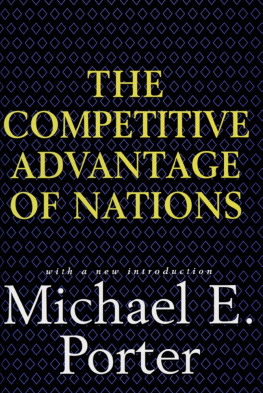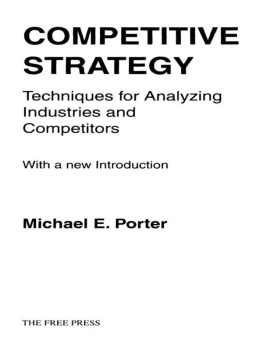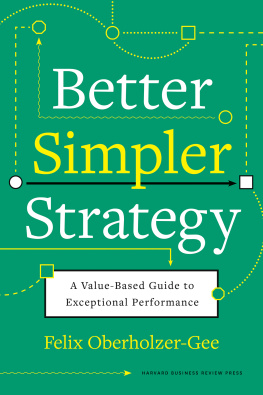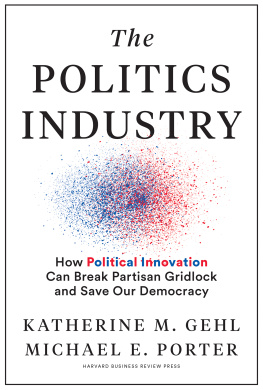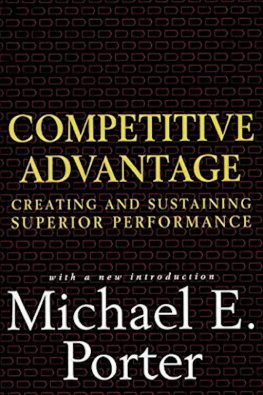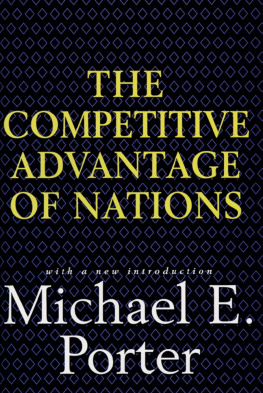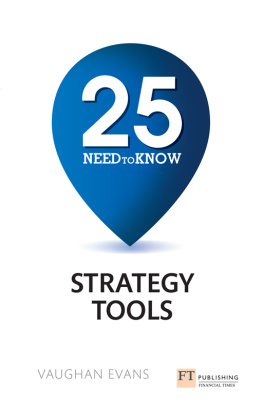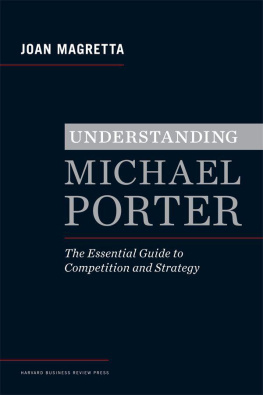Books by Michael E. Porter
The Competitive Advantage of Nations (1990)
Competitive Advantage: Creating and Sustaining Superior Performance (1985)
Cases in Competitive Strategy (1982)
Competition in the Open Economy (with R.E. Caves and A.M. Spence) (1980)
Interbrand Choice, Strategy and Bilateral Market Power (1976)
THE FREE PRESS
A Division of Simon & Schuster Inc.
1230 Avenue of the Americas
New York, NY 10020
www.SimonandSchuster.com
Copyright 1980 by The Free Press
New introduction copyright 1998 by The Free Press
All rights reserved,
including the right of reproduction
in whole or in part in any form.
First Free Press Edition 1980
T HE F REE P RESS and colophon are trademarks of Simon & Schuster Inc.
Library of Congress Cataloging-in-Publication Data
Porter, Michael E.
Competitive strategy: techniques for analyzing industries and competitors: with a new introduction/Michael E. Porter.
p. cm.
Originally published: New York: Free Press, c1980.
Includes bibliographical references and index.
1. Competition. 2. Industrial management. I. Title.
HD41.P671998
658dc2198-9580
CIP
ISBN 0-684-84148-7
ISBN: 978-1-4165-9035-4 (eBook)
Introduction
When Competitive Strategy was first published eighteen years ago, I hoped that it would have an impact. There were reasons to hope, because the book rested on a body of research that had stood the test of peer review, and the draft chapters had survived the scrutiny of my MBA and executive students.
The reception of the book and the role it has played in launching a new field, however, exceeded my most optimistic expectations. Most business school students around the world are exposed to the ideas in the book, invariably in core courses on policy or strategy, but often in specialized elective courses on competitive strategy and also in fields such as economics, marketing, technology management, and information systems. Practitioners in both large and small companies have internalized the ideas, as I learn from numerous thoughtful letters, personal conversations, and now E-mails. Most strategic consultants use the ideas in the book, and entire firms have emerged to assist companies in employing them. Budding financial analysts must read the book prior to certification.
Competitive strategy, and its core disciplines of industry analysis, competitor analysis, and strategic positioning, are now an accepted part of management practice. That a large number of thoughtful practitioners have embraced the book as a powerful tool has fulfilled a career-long desire to influence what happens in the real world.
Competitive strategy has also become an academic field in its own right. Now rich with its own competing ideas, this field is prominent among management researchers. It has also become a thriving area of inquiry among economists. The extent and vitality of the body of literature that traces in some way from the book, whether pro or con, is enormously gratifying. The number of outstanding scholars who are working in this fieldsome of whom I have had the privilege of teaching, mentoring, and writing with has fulfilled my central aspiration of influencing the path of knowledge.
The re-issue of Competitive Strategy has led me to ponder the reasons for the books impact. They are clearer to me now with the passage of time. Competition has always been central to the agenda of companies, but it certainly did not hurt that the book came at a time when companies all over the world were struggling to cope with growing competition. Indeed, competition has become one of the enduring themes of our time. The rising intensity of competition has continued until this day, and spread to more and more countries. Translations of the book in mainland China (1997) or into Czech, Slovak, Hungarian, Polish, or Ukrainian would have been unthinkable in 1980.
The book filled a void in management thinking. After several decades of development, the role of general managers versus specialists was becoming better defined. Strategic planning had become widely accepted as the important task of charting a long-term direction for an enterprise. Early thinkers in the field such as Kenneth Andrews and C. Roland Christensen had raised some important questions in developing a strategy, as I note in Competitive Strategy's original introduction. Yet there were no systematic, rigorous tools for answering these questionsassessing a companys industry, understanding competitors, and choosing a competitive position. Some newly founded strategy consulting firms had moved to fill this void, but the ideas they put forward, such as the experience curve, rested on a single presumed basis of competition and a single type of strategy.
Competitive Strategy offered a rich framework for understanding the underlying forces of competition in industries, captured in the five forces. The framework reveals the important differences among industries, how industries evolve, and helps companies find a unique position. Competitive Strategy provided tools for capturing the richness and heterogeneity of industries and companies while providing a disciplined structure for examining them. The book also brought structure to the concept of competitive advantage through defining it in terms of cost and differentiation, and linking it directly to profitability. Managers looking for concrete ways to tackle strategic plannings difficult questions quickly embraced the book, which rang true to practitioners.
The book also signaled a new direction and provided an impetus for economic thinking. The economic theory of competition at the time was highly stylized. Economists focused mainly on industries; companies were presumed equal or differing primarily in size or in unexplained differences in efficiency. The prevailing view of industry structure encompassed seller concentration and a few sources of barriers to entry. Managers were all but absent in economic models, with virtually no latitude to affect competitive outcomes. Economists were concerned mainly with the societal and public policy consequences of alternative industry structures and patterns of competition. The aim was to push excess profits down. Few economists had ever even considered the question of what the nature of competition implied for company behavior, or how to push profits up. Moreover, economists also lacked the tools to model competition among small numbers of firms whose behavior affected each other. Competitive Strategy identified a range of phenomena that economists, armed with new game-theoretic techniques, have begun to explore mathematically for the first time.
My training and assignmentsfirst an MBA, then an economics PhD, then the unique Harvard Business School challenge of using the case method to teach practitionersrevealed the gap between actual competition and the stylized models. They also created a sense of urgency to develop tools that would inform actual choices in real markets. With rich industry and company knowledge from many case studies, I was able to offer a more sophisticated view of industry competition and bring some structure to the question of how a firm could outperform its rivals. Industry structure involved five forces, not two. Competitive positions could be thought of in terms of cost, differentiation, and scope. In my theory, managers had important latitude to influence industry structure and to position the company relative to others.
Market signaling, switching costs, barriers to exit, cost versus
What has changed since the book was published? In some ways, everything has changed. New technologies, new management tools, new growth industries, and new government policies have appeared and reappeared. But in another sense, nothing has changed. The book provides an underlying framework for examining competition that transcends industries, particular technologies, or management approaches. It applies to high-tech, low-tech, and service industries. The advent of the Internet can alter barriers to entry, reshape buyer power, or drive new patterns of substitution, for example, yet the underlying forces of industry competition stay the same. Industry changes make the ideas in the book even more important, because of the need to rethink industry structure and boundaries. While 1990s companies may look very different than 1980s companies or 1970s companies, superior profitability within an industry still rests on relative cost and differentiation. One may believe that faster cycle time or total quality hold the key to competing, but the acid test comes in how these practices affect industry rivalry, a companys relative cost position, or its ability to differentiate itself and command a price premium.
Next page
